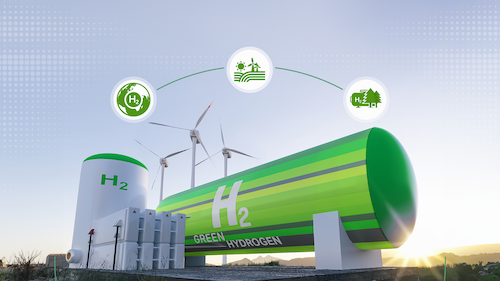As the global transition to clean energy accelerates, green hydrogen is taking centre stage in decarbonising industries, transportation and power generation. India is an attractive contender among the countries competing for supremacy in this emerging field. The country has made impressive strides in clean energy, with renewable sources accounting for 46.3% of the total electricity generation.1
One way India is achieving its transition to clean energy generation is through green hydrogen, a practical solution for industrial sectors where electricity alone isn't sufficient for production. Industrial units for fertiliser production, steel, and oil refining require more than just raw electrical power, and green hydrogen is the ideal, viable, low-emission alternative.
India's abundant renewable energy resources, effective government policymaking, and growing industrial demand make it an excellent destination for the world's green hydrogen needs. It is ideally positioned to become a thriving market, offering Green hydrogen investment opportunities in India. Driven by a lineup of projects, India's green hydrogen policy roadmap 2030, and an increasing adoption, the future of the hydrogen fuel economy in India is promising. Here are seven compelling reasons why the country is set to lead the charge in the hydrogen fuel investment opportunities.
1. Public sector hydrogen investment in India
India is investing heavily in green hydrogen. The National Green Hydrogen Mission (NHMC), adopted in 2023, is the first bold step by the government to accelerate the country's clean energy transition.
The goal of the initiative is to increase green hydrogen production in India to 5 million metric tons per annum by 2030.2 The mission is expected to attract and raise investments in clean energy worth over ₹8 lakh crores and generate over 6,00,000 jobs across the country.3 This effort aligns with India's broader climate commitment to achieve net-zero emissions by 2070.4
2. The SIGHT programme
To aid the overarching National Hydrogen Mission, the government has implemented the Strategic Interventions for Green Hydrogen Transition programme, which outlays a public-sector investment of ₹17,490 crore for the SIGHT programme5 from 2023-2029 to supercharge hydrogen production in India.
The programme offers Production Linked Incentives (PLI) for organisations and companies building electrolysers–devices that break down water into hydrogen and oxygen. Apart from electrolyser manufacturing incentives, India also provides PLIs to all businesses that produce hydrogen as a main or by-product.6
3. Abundance of renewable energy resources
India's potential to lead in renewable energy—and by extension, green hydrogen—largely stems from its rich natural resource base. The country's extensive hydroelectric infrastructure provides a reliable water source for electrolysis, further strengthening the country's readiness for hydrogen initiatives.
What makes this resource advantage even more compelling is the scale at which India can operate. With vast tracts of land available throughout the country and growing infrastructure investments, the nation is well-equipped to fully support integrated green hydrogen initiatives. For green hydrogen production, India will identify regions as green hydrogen hubs.
4. Global clean energy partnerships
India is ramping up its global standing in green energy through key international alliances and global partnerships. The European Union (EU) is one of India's closest allies in its pursuit of green energy adoption and usage. For instance, the third phase of the India-EU Clean Energy and Climate Partnership, which was organised in November 2024, is focused on enhancing the green hydrogen cooperation including assessing infrastructure development feasibility, regulatory and technology cooperation, and strengthening of supply chains.7 Through such partnerships, India is not only attracting global expertise and investment but also signalling its commitment to shaping the international green hydrogen agenda.
5. The India Hydrogen Alliance
India H2 Alliance (IH2A) is an industry-led consortium that comprises leading private and government entities working towards developing a hydrogen value chain and reducing carbon emissions in India's industrial and transport sectors.8 Its Steering Group members include major private players such as Chart Industries, Reliance Industries Limited, JSW Steel, BP, Hero Future Energies (HFE), Aramco, Skeiron, Torrent Power, Godawari Power and Ispat.9 It also collaborates with key government bodies such as NITI Aayog.10
IH2A aims to reduce the cost of hydrogen production, fortify domestic supply chains and promote the development of hydrogen-based applications in India, in close collaboration with the government, private sector and public stakeholders. For instance, the IH2A has proposed a roadmap for constructing 25 green hydrogen projects in India,11 aimed at accelerating India's journey towards clean energy transition.
6. Strategic port infrastructure for exports
India is overhauling its port infrastructure to boost and expand green hydrogen exports. These include the design of specific stations for storing green hydrogen, as well as pipelines and other necessary systems. Ports such as Kandla are taking proactive measures by constructing their electrolysers, aiming for a production capacity of up to 10 MW in the coming years.12 Similarly, the Ministry of Ports, Shipping & Waterways is prioritising improvements at the Tuticorin port13 to support both the production and the export potential of green hydrogen from India.
India is also looking to harness green hydrogen in the shipping sector. The Ministry of New and Renewable Energy is spearheading pilot projects focused on integrating green hydrogen and its derivatives into maritime operations.14
7. Growing domestic and international demand
India faces a growing demand for fuel for fertiliser production, oil and steel refining, and more. According to NITI Aayog, the green hydrogen market in India alone is projected to reach $8 billion by 2030, supported by rising green hydrogen industrial applications in India.15 India is also predicted to consume over 10% of global green hydrogen production for its industries.16
Furthermore, countries across the globe are establishing their own infrastructure to boost green hydrogen production. Being an early mover offers India a strategic advantage in developing its export-oriented economy and enhancing its GDP.
Conclusion
India isn't just joining the green hydrogen race – it's setting the pace. With its mix of ambitious policies, renewable energy capacity, and a clear vision for export and domestic use, the country is positioning itself as a serious global contender. Initiatives like the National Green Hydrogen Mission demonstrate that the government is working in mission mode to make it happen.
For investors, this is a promising sector to consider investing in. As the world shifts toward low-carbon solutions, India offers a unique blend of scale, speed and strategy.
To learn more about India and its renewable energy sector, click here.

